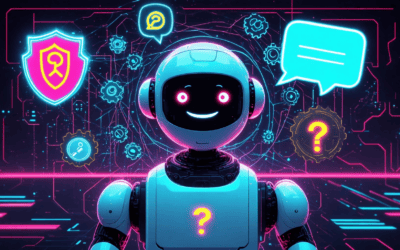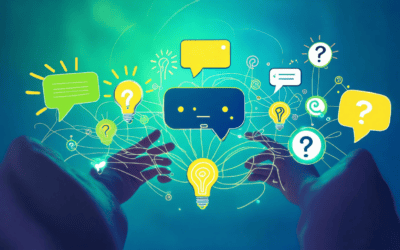In today’s fast-paced digital landscape, businesses are continually seeking innovative solutions to enhance their customer service experience. Enter the proactive chatbot, a game-changing technology that is revolutionizing how companies engage with their customers. This article delves into the transformative role of proactive chatbots in customer service, exploring their numerous benefits for customer engagement and how they significantly enhance the overall customer experience. We will define what a proactive chatbot is, provide real-world examples of proactive AI in action, and discuss the critical shift from reactive to proactive customer support. Additionally, we will examine the different types of chatbots available, including AI-powered and hybrid solutions, and outline the essential steps for implementing proactive chat features in your business. Join us as we uncover the future of chatbots in customer service and the trends shaping this exciting evolution.
What is Proactive Chatbot?
A proactive chatbot is an advanced conversational agent designed to initiate interactions with users rather than waiting for them to reach out. This type of chatbot leverages artificial intelligence (AI) and machine learning to enhance user engagement and improve overall customer experience. Here’s how a proactive chatbot can significantly benefit your business:
- Optimize User Experience: By anticipating user needs and providing timely assistance, proactive chatbots can guide visitors through your website, helping them find information quickly and efficiently. This leads to higher satisfaction rates and encourages repeat visits.
- Increase Website Traffic: Proactive chatbots can engage users through personalized messages and prompts, encouraging them to explore more content or products on your site. This increased interaction can lead to higher traffic and visibility.
- Enrich Your Contact Base: These chatbots can collect valuable data from users during interactions, such as preferences and feedback, which can be used to tailor marketing strategies and improve service offerings.
- Boost Conversion Rates: By proactively addressing user queries and providing relevant recommendations, chatbots can guide potential customers through the sales funnel, ultimately leading to higher conversion rates and increased sales.
- Enhance Customer Support: Proactive chatbots can monitor user behavior and reach out to offer help before users encounter issues, reducing frustration and improving overall support efficiency.
According to a study by Gartner, by 2025, 75% of customer service interactions will be powered by AI, highlighting the growing importance of proactive chatbots in modern business strategies. Implementing a proactive chatbot can thus be a game-changer for businesses looking to enhance user engagement and drive sales.
Benefits of Proactive Chatbots for Customer Engagement
Proactive chatbots offer numerous advantages that can significantly enhance customer engagement. Here are some key benefits:
- Real-Time Interaction: Proactive chatbots can engage customers in real-time, providing immediate responses to inquiries and reducing wait times.
- Personalized Communication: By analyzing user data, these chatbots can tailor interactions based on individual preferences, creating a more personalized experience.
- 24/7 Availability: Unlike human agents, proactive chatbots are available around the clock, ensuring that customer inquiries are addressed at any time.
- Cost Efficiency: Implementing a proactive chatbot can reduce operational costs associated with customer service, allowing businesses to allocate resources more effectively.
These benefits make proactive chatbots an essential tool for businesses aiming to improve their customer engagement strategies.
How Proactive Chatbots Enhance Customer Experience
Proactive chatbots play a crucial role in enhancing the overall customer experience. Here’s how they achieve this:
- Anticipating Customer Needs: By analyzing user behavior, proactive chatbots can predict customer needs and offer assistance before issues arise.
- Streamlining Processes: These chatbots can simplify complex processes, guiding users through tasks such as booking appointments or making purchases.
- Gathering Feedback: Proactive chatbots can solicit feedback from users, providing valuable insights that can help improve products and services.
- Building Relationships: By engaging users in meaningful conversations, proactive chatbots can foster stronger relationships between brands and customers.
Incorporating proactive chatbots into your customer service strategy can lead to a more satisfying and efficient experience for your users, ultimately driving loyalty and repeat business.

Understanding the Role of Proactive Chatbots in Customer Service
Proactive chatbots play a pivotal role in transforming customer service by anticipating user needs and engaging them before they even reach out for help. This forward-thinking approach not only enhances customer satisfaction but also streamlines operational efficiency. By leveraging artificial intelligence, these chatbots can analyze user behavior and preferences, allowing businesses to deliver tailored interactions that resonate with their audience.
Benefits of Proactive Chatbots for Customer Engagement
Proactive chatbots offer numerous benefits that significantly enhance customer engagement. One of the primary advantages is their ability to provide real-time assistance, which can lead to increased customer satisfaction and loyalty. For instance, e-commerce chatbots can analyze customer behavior to offer personalized product recommendations, assist with order tracking, and resolve queries instantly. Platforms like Shopify utilize proactive chatbots to enhance user experience and boost conversion rates.
Additionally, proactive chatbots can help businesses identify and address potential issues before they escalate. For example, financial institutions deploy proactive AI to monitor transactions and alert customers about potential fraud or unusual activity. Bank of America’s Erica chatbot exemplifies this by providing insights into spending habits and notifying users of upcoming bills, thus helping them manage their finances effectively.
How Proactive Chatbots Enhance Customer Experience
Proactive chatbots significantly enhance the overall customer experience by providing timely and relevant information. In the telecommunications sector, companies like Vodafone use proactive AI to identify customers at risk of leaving by analyzing usage patterns. These chatbots can then offer tailored retention offers or service upgrades, effectively reducing churn rates.
Moreover, in the travel and hospitality industry, proactive AI chatbots assist customers by providing real-time updates on flight statuses and suggesting itinerary changes. The KLM chatbot, for instance, proactively informs travelers about gate changes and delays, ensuring a smoother travel experience. This level of proactive engagement not only fosters customer loyalty but also positions businesses as attentive and responsive to their clients’ needs.
For more insights on how chatbots can revolutionize customer service, explore our article on revolutionizing customer support.
What Does Proactive Chat Mean?
Proactive chat, often referred to as proactive live chat, is a customer service strategy that involves initiating conversations with website visitors rather than waiting for them to engage. This approach is designed to enhance user experience and increase conversion rates by offering assistance at critical moments during the customer journey. By implementing proactive chat, businesses can significantly improve customer satisfaction and engagement.
The Shift from Reactive to Proactive Customer Service
The transition from reactive to proactive customer service marks a significant evolution in how businesses interact with their customers. Reactive customer service typically involves responding to inquiries and issues only after they arise, which can lead to frustration and lost opportunities. In contrast, proactive customer service anticipates customer needs and reaches out to them before they even ask for help.
Key elements of proactive chat include:
- Timing and Triggers: Implementing proactive chat requires identifying the right moments to engage visitors, such as when they spend a certain amount of time on a page, exhibit signs of hesitation, or revisit a site multiple times. Research indicates that timely interventions can significantly improve customer satisfaction.
- Personalization: Tailoring messages based on user behavior, demographics, or previous interactions can make proactive chat more effective. Personalized greetings or offers can lead to higher engagement rates.
- Automation and AI: Utilizing chatbots for initial interactions can streamline the process, allowing for 24/7 support and quick responses to common inquiries. However, it’s crucial to ensure a seamless transition to human agents when needed.
- Analytics and Feedback: Monitoring chat interactions and gathering feedback can help refine proactive strategies. Analyzing data on user engagement and satisfaction can inform future improvements.
- Integration with Other Channels: Proactive chat should complement other customer service channels, such as email and social media, to provide a cohesive support experience.
By implementing these strategies, businesses can leverage proactive chat to not only assist customers effectively but also drive sales and enhance brand loyalty. For more insights on enhancing customer support, check out our article on elevating customer support with conversational AI chatbots.
Key Features of Proactive Chat Solutions
Proactive chat solutions come equipped with several features that enhance their effectiveness in customer service. These features not only improve customer interactions but also streamline operational efficiency.
- Real-Time Engagement: Proactive chat allows businesses to engage with customers in real-time, addressing their queries and concerns as they arise.
- Behavior Tracking: Advanced analytics tools track user behavior to identify when a visitor may need assistance, enabling timely outreach.
- Multilingual Support: Many proactive chat solutions offer multilingual capabilities, allowing businesses to cater to a diverse customer base.
- Integration with CRM Systems: Seamless integration with customer relationship management (CRM) systems ensures that all interactions are logged and can be referenced in future communications.
- Customizable Chatbots: Businesses can customize chatbots to reflect their brand voice and provide tailored responses to common inquiries.
These features make proactive chat an invaluable tool for businesses looking to enhance their customer service experience. For further exploration of how AI chatbots can revolutionize customer service, visit this resource.
What Does Proactive Chat Mean?
Proactive chat refers to the practice of initiating conversations with customers rather than waiting for them to reach out. This approach is essential in customer support as it allows businesses to engage users at critical moments, enhancing their overall experience. By leveraging proactive chat, companies can anticipate customer needs, address potential issues before they escalate, and ultimately foster stronger relationships with their audience.
The Shift from Reactive to Proactive Customer Service
The transition from reactive to proactive customer service marks a significant evolution in how businesses interact with their customers. Reactive customer service relies on responding to inquiries and issues as they arise, often leading to frustration and dissatisfaction. In contrast, proactive customer service involves anticipating customer needs and reaching out with solutions or assistance before they even ask. This shift not only improves customer satisfaction but also increases loyalty and retention.
Key Features of Proactive Chat Solutions
Proactive chat solutions come equipped with several key features that enhance their effectiveness in customer service:
- Automated Triggers: These systems can automatically initiate conversations based on user behavior, such as time spent on a page or specific actions taken, ensuring timely engagement.
- Personalization: By utilizing customer data, proactive chatbots can tailor conversations to individual preferences, making interactions more relevant and engaging.
- Multilingual Support: Many proactive chat solutions, like those offered by Brain Pod AI, provide multilingual capabilities, allowing businesses to connect with a global audience effectively.
- Integration with CRM Systems: Proactive chat solutions can integrate seamlessly with customer relationship management (CRM) systems, enabling a more holistic view of customer interactions and history.
For businesses looking to enhance their customer service experience, implementing proactive chat features can lead to significant improvements in engagement and satisfaction. To explore more about the benefits of chatbots for customer service, check out our article on elevating customer support with conversational AI chatbots.

How do I enable proactive chat?
Enabling proactive chat is essential for enhancing customer interactions and ensuring timely responses. By implementing proactive chat features, businesses can engage customers before they even initiate a conversation. Here’s how to enable proactive chat in Microsoft Teams:
- Access the Admin Center: Log in to the Microsoft Teams admin center using your administrator credentials.
- Navigate to Chat Widgets: In the left-hand menu, select “Chat” and then choose “Chat Widgets” to view the list of available chat widgets.
- Select the Desired Workstream: Identify the workstream associated with the chat widget you wish to configure. Click on it to open the settings.
- Edit Chat Widget Settings: Click on the “Edit” button next to the chat widget you want to modify.
- Configure Proactive Chat: On the “Chat Widget” tab within the Chat Channel Settings page, locate the “Proactive Chat” option.
- Enable the Toggle: Set the toggle for Proactive Chat to On. This will activate proactive chat features, allowing your chat widget to initiate conversations based on user behavior.
- Save Changes: After making the necessary adjustments, ensure you click “Save” to apply the changes to your chat widget.
For further information and updates on proactive chat features, refer to the official Microsoft documentation: Microsoft Learn – Configure proactive chat.
Best Practices for Configuring Customer Service Chatbots
When configuring proactive chat features, it’s crucial to follow best practices to maximize engagement and effectiveness. Here are some key strategies:
- Personalization: Tailor the proactive messages based on user behavior and preferences. This can significantly enhance user engagement and satisfaction.
- Timing: Initiate proactive chats at strategic moments, such as when a user lingers on a page or shows signs of hesitation during the purchasing process.
- Clear Call to Action: Ensure that the proactive chat messages include a clear call to action, guiding users on what to do next, whether it’s asking a question or exploring a product.
- Monitor and Optimize: Regularly analyze the performance of proactive chat interactions and make adjustments based on user feedback and engagement metrics.
By implementing these best practices, businesses can effectively utilize chatbots for customer service to foster deeper connections with their audience.
Tools and Technologies for Enabling Proactive Chat
To successfully enable proactive chat, leveraging the right tools and technologies is essential. Here are some recommended solutions:
- AI Chatbots: Utilize AI chatbots that can learn from user interactions and provide personalized responses, enhancing the overall customer experience.
- Integration Platforms: Use platforms that allow seamless integration of chatbots into existing systems, ensuring a smooth flow of information and user interactions.
- Analytics Tools: Implement analytics tools to track user interactions and gather insights, which can help refine proactive chat strategies over time.
These tools can significantly enhance the capabilities of customer support chatbots, making them more effective in engaging users proactively.
The Future of Chatbots in Customer Service
As we look ahead, the role of proactive chatbots in customer service is set to evolve significantly. With advancements in artificial intelligence and machine learning, these chatbots are becoming increasingly sophisticated, allowing businesses to enhance their customer engagement strategies effectively. The integration of proactive chatbots into customer service frameworks not only streamlines communication but also anticipates customer needs, leading to improved satisfaction and loyalty.
Trends Shaping the Evolution of Customer Service Chatbots
Several trends are influencing the future of customer service chatbots. One of the most notable is the shift towards personalization. Customers now expect tailored interactions that cater to their specific preferences and behaviors. Proactive chatbots can analyze past interactions and purchase history to provide personalized recommendations, making the customer feel valued and understood.
Another trend is the increasing use of AI chatbots for customer service. These advanced systems can handle complex queries and provide real-time support, reducing the need for human intervention. For instance, platforms like Brain Pod AI are leading the way in developing AI-driven solutions that enhance customer interactions through intelligent automation.
The Impact of AI on Customer Support Chatbots
The impact of AI on customer support chatbots is profound. AI technologies enable chatbots to learn from interactions, improving their responses over time. This capability not only enhances the efficiency of customer service but also allows for proactive engagement. For example, a proactive chatbot can initiate conversations based on user behavior, such as offering assistance when a customer appears to be struggling with a website feature.
Moreover, the integration of multilingual support in chatbots is breaking down language barriers, allowing businesses to cater to a global audience. This feature is essential for companies looking to expand their reach and improve customer satisfaction across diverse markets. By utilizing chatbots for customer support, businesses can ensure that language differences do not hinder effective communication.
What is a proactive chatbot?
A proactive chatbot is an advanced AI-driven tool designed to engage users by initiating conversations rather than simply responding to inquiries. This type of chatbot leverages data analytics and user behavior patterns to anticipate customer needs, providing timely assistance and information. By proactively reaching out to users, these chatbots enhance customer engagement and streamline the support process, making them an essential component of modern chatbots for customer service.
Understanding the Role of Proactive Chatbots in Customer Service
Proactive chatbots play a crucial role in customer service by improving response times and increasing customer satisfaction. They can identify when a user may need assistance based on their behavior, such as spending too much time on a page or showing signs of frustration. By reaching out at the right moment, proactive chatbots can guide users through their journey, answer questions, and resolve issues before they escalate.
Benefits of Proactive Chatbots for Customer Engagement
The benefits of proactive chatbots for customer engagement are numerous. They can:
- Enhance User Experience: By providing immediate assistance, proactive chatbots reduce wait times and improve overall user satisfaction.
- Increase Conversion Rates: Engaging customers at critical moments can lead to higher conversion rates, as proactive chatbots can guide users through the purchasing process.
- Collect Valuable Data: These chatbots gather insights on customer preferences and behaviors, enabling businesses to tailor their services and marketing strategies effectively.
How Proactive Chatbots Enhance Customer Experience
Proactive chatbots enhance customer experience by creating a more personalized interaction. They can remember past interactions and preferences, allowing for tailored responses that resonate with users. Additionally, by integrating with other systems, such as CRM platforms, proactive chatbots can provide contextually relevant information, making conversations more meaningful and efficient.
What is an example of a proactive AI?
An example of proactive AI in action is the use of chatbots on e-commerce websites. For instance, when a customer browses a product page for an extended period, a proactive chatbot may pop up to offer assistance, suggest related products, or provide discounts. This not only helps in guiding the customer but also increases the likelihood of a sale.
Real-World Applications of Proactive AI in Customer Service
Proactive AI is being utilized across various industries to enhance customer service. Companies like Brain Pod AI have developed sophisticated AI solutions that enable businesses to automate customer interactions effectively. These applications demonstrate how proactive AI can streamline processes and improve customer satisfaction.
Case Studies of Successful Proactive Chatbot Implementations
Several companies have successfully implemented proactive chatbots to improve their customer service. For example, a leading online retailer used a proactive chatbot to engage customers during peak shopping seasons. The chatbot provided personalized recommendations and answered queries, resulting in a significant increase in sales and customer satisfaction ratings.
Comparing Proactive AI with Reactive AI
Proactive AI differs from reactive AI in its approach to customer interaction. While reactive AI responds to customer inquiries as they arise, proactive AI anticipates customer needs and initiates conversations. This proactive approach leads to a more engaging and satisfying customer experience, as users feel supported throughout their journey.




